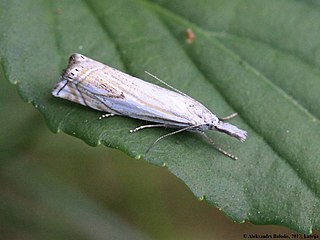Scoparia aequipennalis is a species of moth in the family Crambidae. It is found on the Azores.

Crambus uliginosellus is a species of moth in the family Crambidae. It was first described by Zeller in 1850 and is currently found in most of Europe, except Portugal, Slovenia, Croatia and Ukraine.
Eoophyla mimicalis is a moth in the family Crambidae. It was described by George Hampson in 1917. It is found in Cameroon, the Republic of the Congo, the Democratic Republic of the Congo, Ghana, Kenya, Malawi, Nigeria, Sierra Leone, Tanzania and Uganda.
Eoophyla nyasalis is a moth in the family Crambidae. It was described by George Hampson in 1917. It is found in Cameroon, the Democratic Republic of the Congo, Ethiopia, Kenya, Malawi, Nigeria, Sierra Leone, Tanzania and Zambia.
Nymphicula ochrepunctalis is a moth in the family Crambidae. It was described by David John Lawrence Agassiz in 2014. It is found in Papua New Guinea and Australia, where it has been recorded from Queensland and the Northern Territory.
Nymphicula susannae is a moth in the family Crambidae. It was described by David John Lawrence Agassiz in 2014. It is found in Papua New Guinea.
Ptychopseustis eutacta is a moth in the family Crambidae. It is found in Australia, where it has been recorded from Queensland.
Eudonia perierga is a moth in the family Crambidae. It was described by Edward Meyrick in 1885. It is found in Australia, where it has been recorded from Tasmania.
Eudonia meliturga is a moth in the family Crambidae. It was described by Edward Meyrick in 1905. This species is endemic to New Zealand.
Scoparia dryphactis is a moth in the family Crambidae. It was described by Edward Meyrick in 1911. This species is endemic to New Zealand.
Trigonoorda psarochroa is a moth in the family Crambidae. It was described by Turner in 1908. It is found in Australia, where it has been recorded from Queensland.
Auchmophoba alternata is a moth in the family Crambidae. It was described by William Warren in 1895. It is found in India (Assam), Borneo, Sumbawa and Australia, where it has been recorded Queensland.
Myriostephes asphycta is a moth in the family Crambidae. It was described by Turner in 1915. It is found in Australia, where it has been recorded from the Northern Territory.
Piletocera agathanalis is a moth in the family Crambidae. It was described by William Schaus in 1924. It is found in Panama.
Salbia thyrsonoma is a moth in the family Crambidae. It is found in Bolivia.
Syllepte leucographalis is a moth in the family Crambidae. It was described by George Hampson in 1912. It is found in Indonesia (Bali).
Tylostega photias is a moth in the family Crambidae. It was described by Edward Meyrick in 1894. It is found on Borneo.
Mnesictena pantheropa is a moth in the family Crambidae. It was described by Edward Meyrick in 1884. It is endemic to New Zealand, where it has been recorded from the Chatham Islands.
Voliba psammoessa is a moth in the family Crambidae. It was described by Turner in 1908. It is found in Australia, where it has been recorded from Queensland.
Voliba pycnosticta is a moth in the family Crambidae. It was described by Turner in 1908. It is found in Australia, where it has been recorded from Queensland.
